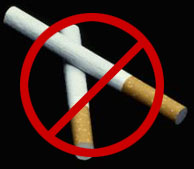|
Cigarette Smoking
 A
tremendous amount of evidence shows that cigarette smoking is
the most important risk
factor for coronary heart disease. Cigarette smoking increases
the triglyceride (fat) level
and lowers the HDL-C (good cholesterol) level in your blood.
When a person stops smoking, benefits occur immediately! After
one year of not smoking, the coronary heart disease risk is lowered
by 50% as compared with those who continue to smoke. A
tremendous amount of evidence shows that cigarette smoking is
the most important risk
factor for coronary heart disease. Cigarette smoking increases
the triglyceride (fat) level
and lowers the HDL-C (good cholesterol) level in your blood.
When a person stops smoking, benefits occur immediately! After
one year of not smoking, the coronary heart disease risk is lowered
by 50% as compared with those who continue to smoke.
What can you do?
- 1. Participate in formal
smoking cessation programs to help you quit smoking.
2. Encourage family members who smoke to quit also.
Factors Leading to Development of a Blood Clot
(Thrombus)
Blood is made up of cells that
move about in a liquid called plasma. There are three types of
blood cells: red blood cells, white blood cells and platelets.
Platelets help stop bleeding. If a blood vessel is cut, platelets
stick together, forming a blood clot. Blood clotting keeps you
from bleeding to death when you have a cut. Scabs are clots on
the surface of the skin.
Sometimes, a clot may occur in
a blood vessel that has not been cut. If the vessel is already clogged with plaque
from too much cholesterol, the blood clot may block the flow
of blood to your tissues. If the clot blocks one of the
heart's arteries, it can cause a heart attack. If the clot
blocks an artery to the brain, a stroke may occur.
Doctors
now prescribe aspirin to patients who have had a heart attack
to help keep them from having another one. It also helps
prevent men from having a first heart attack. Take
aspirin only upon your physician's recommendation, since aspirin is also a blood thinner
and you may bleed more easily if you take aspirin regularly.
Other
Heart Disease Risk Factors
- Diabetes mellitus.
- Physical inactivity.
- Obesity.
- Postmenopausal status without
hormone replacement - hormones help prevent heart disease.
- Psychosocial factors - stress,
hostility or social isolation.
- Elevated homocysteine level
- you can reduce your homocysteine level by getting
lots of B-vitamins in your diet. Good sources of B -vitamins
include whole grains, fruits, vegetables
and lean meats.
- Oxidation of LDL-Cholesterol
- eating foods high in vitamin E, an antioxidant, can prevent this. Good sources
include grains, fruits, vegetables and
vegetable oils.
Web
Site Assignments:
Explore
the web sites listed below. Each of these sites have activities
for you to complete to practice
what you have learned.
www.hsf.ca . The Heart and Stroke Foundation of
Canada. Take the Ticker Test to test your own risk. Click
on Test Your Knowledge. Then click on What Is Heart
Disease. Click on Risk Factors. Click on the hearts
to go through all of them. Once you are through, click on Signs
and Symptoms. Also explore the Heart Smart Kids -
pretend you're a kid. Click on Dear Family. Be sure to
do the Active Play Every Day and the Grow with Us
sections.
www.margarine.org . Margarine Organization. Look over
for recipe ideas, information about fats and other information.
www.healthyfridge.org . Healthy fridge campaign. Click on
Open the Door to a
Healthy Heart, then Healthy
Fridge, and then Top 10 for a Heart-Healthy Refrigerator.
After reading the Top 10, click on Home, Contests & More
and Test Your Saturated Fat I.Q.
www.eatright.org/womenshealth/heartdisease.html . Visit the American Dietetic Association
web site to learn more about heart disease risk factors for women.
www.quakeroatmeal.com.Take the Heart Smart Challenge as discussed
earlier in the lesson.
Quizzes
for This Lesson
Here are two other quizzes you
can take on the net!
1. Cholesterol and Heart Disease
I.Q. Quiz. nhlbi.nih.gov/
2. High Blood Pressure Quiz www.mayohealth.org/mayo/9808/htm/highblood/nonjsattention.html
Summary
You can do five important
things to prevent heart disease and stroke!
- 1. Eat a heart-healthy diet! Practice balance,
variety and moderation when planning and eating meals, using
the Food Guide Pyramid. Select foods that are low in total fat,
saturated fat and cholesterol.
2. Exercise! Regular physical activity should be an
important part of your daily routine.
 3. Watch your weight!
Always strive to maintain a healthy body weight. 3. Watch your weight!
Always strive to maintain a healthy body weight.
-
- 4. Be a non-smoker! When a person stops smoking, benefits
occur immediately!
-
- 5. Moderate or refrain from alcohol.
Each of these behaviors should
be part of your and your family's lifestyle. You will reap the
benefits by feeling better and helping to prevent heart disease
and stroke.
   [ LESSONS || SITE
MAP || LOCAL AGENTS || RESOURCES || PEOPLE ]
[ LESSONS || SITE
MAP || LOCAL AGENTS || RESOURCES || PEOPLE ]
 Issued in furtherance of Cooperative Extension
work, Acts of Congress of May 8 and June 30, 1914, in cooperation
with the United States Department of Agriculture. The Louisiana
Cooperative Extension Service provides equal opportunities in
programs and employment. Information and Graphics on this site
are copyright protected by LSU Agricultural Center's Louisiana Cooperative Extension Services.
For more information
on the EFNEP program, contact EFNEPMail@agcenter.lsu.edu. Issued in furtherance of Cooperative Extension
work, Acts of Congress of May 8 and June 30, 1914, in cooperation
with the United States Department of Agriculture. The Louisiana
Cooperative Extension Service provides equal opportunities in
programs and employment. Information and Graphics on this site
are copyright protected by LSU Agricultural Center's Louisiana Cooperative Extension Services.
For more information
on the EFNEP program, contact EFNEPMail@agcenter.lsu.edu.
|